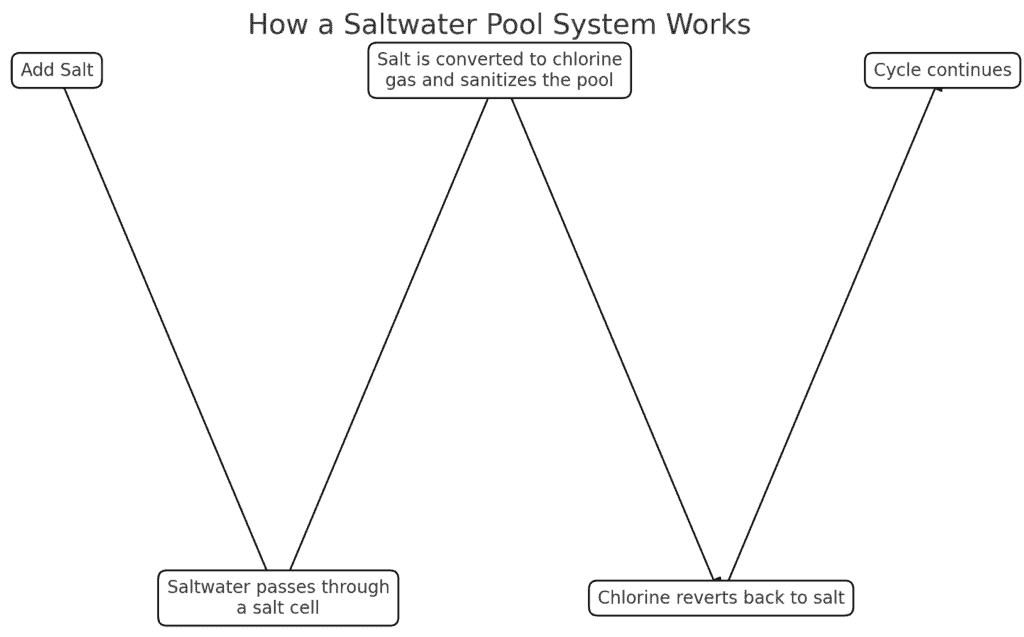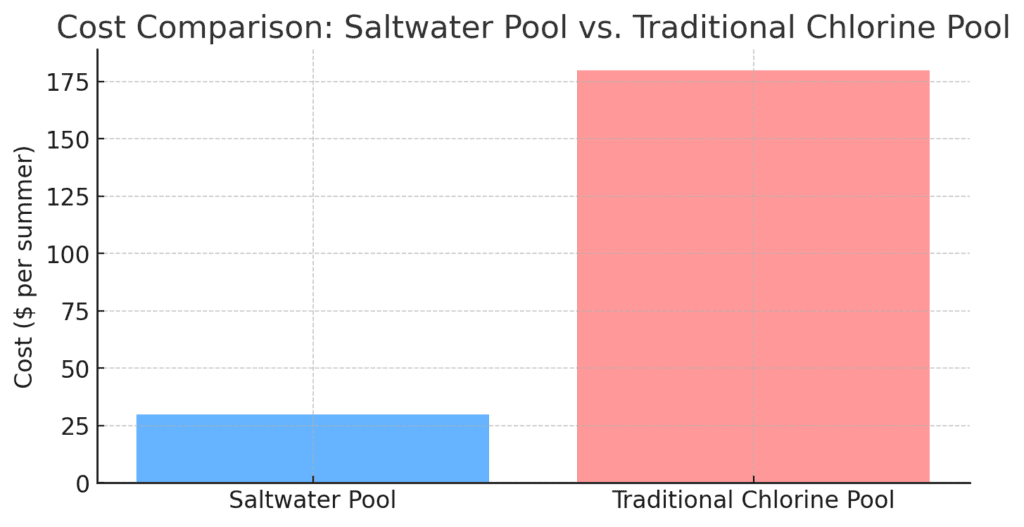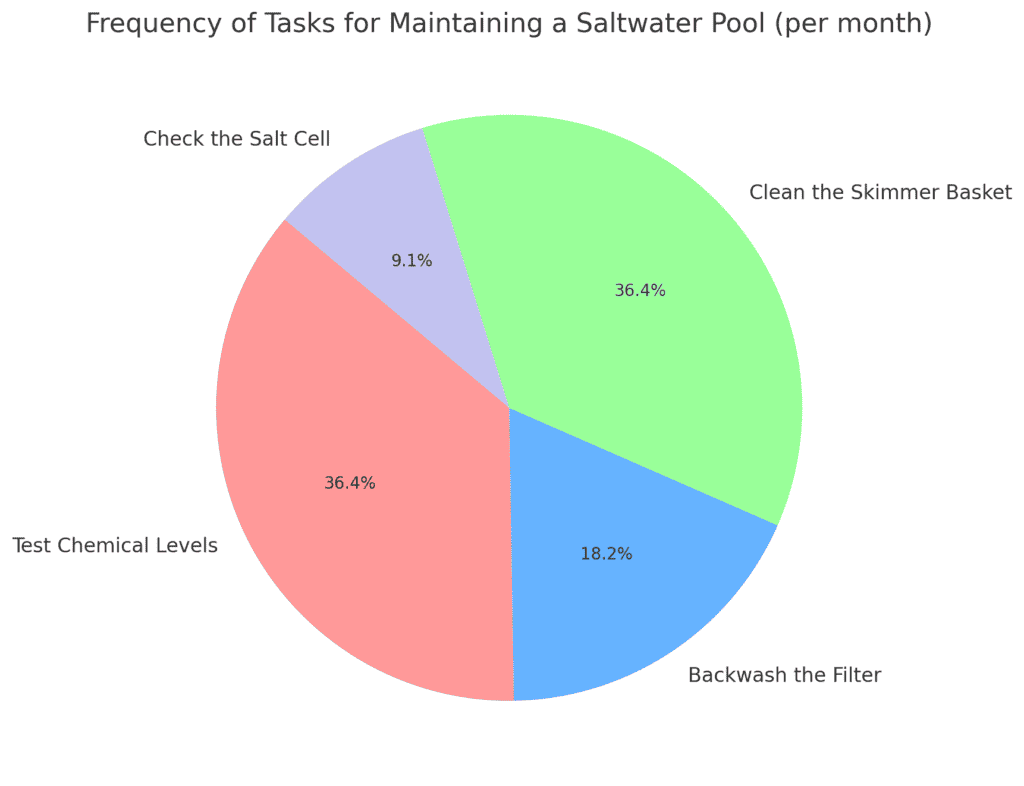
A saltwater pool is a popular choice for many homeowners because it uses salt to keep the water clean instead of harsh chemicals like chlorine. However, many pool owners are unsure about how much salt their pool needs to maintain the ideal salt level.
The optimal salt level for a saltwater pool is between 2,700 and 3,400 parts per million (ppm), with 3,200 ppm being the sweet spot.
In this article, I wanted to break down the ideal amount of salt to use in a saltwater swimming pool. I’ve linked to a handy pool salt calculator and also have some tips to maintaining your pool.
This article contains affiliate links.
Table of Contents
How Much Salt Does a Saltwater Pool Use?
The ideal salt level for a saltwater pool is between 2,700-3,400 ppm, with 3,200 ppm being the ideal level. Calculating the amount of salt needed for your pool depends on several factors, including the pool’s volume and the ideal salt level.
To calculate the amount of salt needed, you can use a pool salt calculator. These calculators use your pool’s volume and current salt level to estimate the pounds of salt needed to reach the ideal level. It is important to note that the amount of salt required may vary depending on the size and shape of your pool.
Testing Salt Levels
Testing the salt levels in your pool is essential to ensure the proper functioning of the salt chlorine generator. You can use salt test strips or a testing kit to measure the salt levels in your pool.
To test the salt levels, take a water sample from the pool and follow the instructions on the test kit or strip.
The test will provide a reading in ppm (parts per million). If the salt level is too low, you will need to add salt to the pool. If the salt level is too high, you can dilute the pool water or wait for the salt level to decrease naturally.
It is important to note that other factors, such as the pool’s alkalinity and pH levels, can also affect the salt levels in your pool. It is recommended to test the salt levels regularly and adjust as needed to maintain the ideal level.
Popular Residential Pool Sizes
| Pool Size (feet, gallons) | Salt Needed (lbs) | Frequency of Adding Salt |
|---|---|---|
| Small Pool (10 ft x 20 ft; 7400 gallons) | Approx. 22.44 | Once every 2 to 4 weeks |
| Medium Pool (16 ft x 32 ft; 21,000 gallons) | Approx. 63.13 | Once every 1 to 2 months |
| Large Pool (20 ft x 40 ft; 36,000 gallons) | Approx. 107.71 | Once every 1 to 2 months |
Please note that the values in the table are approximate and can vary based on individual pool characteristics, usage, and environmental factors. Regularly testing the water and consulting with a pool specialist will help ensure that your saltwater pool remains properly maintained and balanced.
How Does a Saltwater Pool System Work?
Saltwater pool systems offer a number of benefits over a regular chlorine pool. Saltwater swimming pools draw on dissolved salt in the water to generate chlorine, which is required to sanitize the pool water. Here’s how it works:
- Salt is added to the pool water. The amount of salt added depends on the size of the pool. Generally, pool salt comes in 40-pound bags, and you need to add about 200 pounds of salt to the pool water to bring your salt levels up to 3,200 PPM.
- The saltwater passes through a salt cell, also known as a chlorine generator. The cell uses electrolysis to convert the salt into chlorine gas. The chlorine gas dissolves in the water and sanitizes the pool.
- The chlorine in the water reverts back to salt through a process called electrolysis. This cycle continues, and the salt level remains constant as long as there is no water loss due to splash-out or backwashing.
The saltwater pool system is a low-maintenance option compared to traditional chlorine pools. The system requires less monitoring and maintenance since the chlorine level is automatically regulated by the salt cell. Additionally, saltwater pools are gentler on the skin and eyes, making them a more comfortable swimming experience.

Pros and Cons of a Saltwater Pool
Saltwater pools have become increasingly popular in recent years due to their many benefits. However, like any other pool, they also have their drawbacks. In this section, we will discuss the pros and cons of a saltwater pool.
Pros
- Softer on Skin and Eyes: Saltwater pools use an electrolytic chlorine generator to produce chlorine from salt, which is much gentler on your skin and eyes compared to traditional chlorine pools.
- Lower Annual Costs: Saltwater pools are more budget-friendly than traditional chlorine pools. The cost of a summer supply of salt is estimated to be between $20 to $30, while chlorine can cost around $150 to $180 for the same period and pool size.
- Less Harsh Chemicals: Saltwater pools use fewer harsh chemicals, making them safer for swimmers and the environment.
- Reduced Scaling and Corrosion: Saltwater pools have a lower risk of scaling and corrosion, which can damage pool equipment and surfaces.
- Pump Running Time: Saltwater pools require less pump running time than traditional chlorine pools, which can lead to energy savings.
Cons
- Higher Installation Costs: Saltwater pool systems are more expensive to install than traditional chlorine pool systems.
- Requires Monitoring of Cyanuric Acid Levels: Saltwater pools still require the use of cyanuric acid to stabilize the chlorine levels, which needs to be monitored regularly.
- Potential for Scaling: While saltwater pools are less prone to scaling than traditional chlorine pools, they can still develop scaling if the pH and alkalinity levels are not properly balanced.
- Not Completely Chemical-Free: Saltwater pools still use chlorine to sanitize the water, so they are not completely chemical-free.
- Can Still Cause Corrosion: Saltwater pools can still cause corrosion if the pH and alkalinity levels are not properly balanced.

Can You Put Too Much Salt in A Saltwater Pool?
it is possible to put too much salt in a saltwater pool. While salt is essential for the operation of a saltwater chlorinator system, excessive salt levels can lead to several issues:
- High Salinity: When salt levels exceed the recommended range (typically between 2500 to 4000 ppm), the water becomes excessively salty. This high salinity can cause discomfort for swimmers, making the water feel overly “salty” and potentially irritating to the eyes, skin, and mucous membranes.
- Corrosion: Excessive salt levels can accelerate the corrosion of metal components in and around the pool, including ladders, handrails, and pool equipment. Corrosion can lead to premature equipment failure and potentially costly repairs.
- Damage to Pool Surfaces: High salt concentrations can also damage certain pool surfaces, especially those made of stone or concrete. The salt can draw moisture to the surface, causing efflorescence and weakening the structure over time.
- Poor Chlorine Production: Paradoxically, extremely high salt levels can negatively impact the performance of saltwater chlorinators. If the salt concentration is far beyond the recommended range, the chlorine production might decrease, leading to inadequate sanitization of the pool water.
- Increased Maintenance Costs: Adding excessive salt can lead to unnecessary expenses, as you’ll need to dilute the pool water or partially drain and refill the pool to lower the salt concentration.
- Soil Salinization: If pool water containing excessive salt is allowed to seep into the surrounding soil, it can lead to soil salinization. High salt levels in the soil can disrupt the osmotic balance of plant roots, making it difficult for them to absorb water and essential nutrients. This can result in stunted growth, wilting, and eventually, the death of plants.
- Disruption of Microbial Activity: High salt levels in the soil can also negatively affect soil microbial activity, reducing the beneficial interactions between plants and soil microbes. This disruption can further impact the overall health and nutrient cycling in the surrounding ecosystem.
To avoid these issues, monitor the salt concentration in your saltwater pool regularly. Use a saltwater test kit to measure the salt level and make adjustments as necessary to keep it within the recommended range.
If you suspect that you’ve added too much salt, consult with a pool professional to determine the best course of action for restoring the proper salt balance in your pool.
Additionally, follow the manufacturer’s guidelines and recommendations for your specific saltwater system to ensure the pool operates effectively and safely.
Maintaining a Saltwater Pool
Saltwater Pool Maintenance
Maintaining a saltwater pool requires regular maintenance to keep the water clean and healthy. One of the advantages of a saltwater pool is that it uses a saltwater chlorinator to produce chlorine, which means you don’t need to add traditional chlorine to the pool. However, you’ll still need to shock the pool if it becomes dirty or algae-infested.
To keep your saltwater pool in optimal condition, you should test the chemical levels in the water at least once a month. This includes testing the pH level, free chlorine, alkalinity, calcium, stabilizer, and salt levels. You can purchase a test kit from a pool store or hire a local professional to test the water for you.
Saltwater Pool Equipment
There are several pieces of equipment you’ll need to maintain a saltwater pool. These include:
- Salt Cell: The salt cell is responsible for producing chlorine from the salt in the water.
- Skimmer: The skimmer removes debris from the surface of the water.
- Chlorinator: the chlorinator distributes the chlorine throughout the pool.
- Filter: The filter removes impurities from the water.
- Pump: the pump circulates the water through the system.
It’s important to keep all of the equipment in good working condition to ensure that your pool stays clean and healthy. You should backwash the filter regularly and clean the skimmer basket to prevent clogging. You should also check the salt cell periodically to make sure it’s clean and functioning properly.
Tips for Keeping a Saltwater Pool Healthy
To keep your saltwater pool healthy, you should maintain the proper salinity levels and total dissolved solids. The ideal salinity level for a saltwater pool is between 2,700 and 3,400 parts per million (ppm), with 3,200 ppm being ideal. You can use a pool salt calculator to determine how much salt to add to the water.
High levels of total dissolved solids can cause scaling and corrosion in the pool, so it’s important to monitor these levels and drain and refill the pool as necessary. You should also run the pump for at least 8 hours a day to keep the water circulating.
Finally, you should be vigilant about algae and other microorganisms in the water. Regular testing and maintenance can help prevent these issues, but if you do notice algae or other problems, you should address them promptly to keep your pool in the circular sweet spot of a healthy saltwater pool.

What Other Additives Should Go Into a Saltwater Pool?
Several other additives are important for maintaining a healthy and balanced saltwater pool. These additives help to ensure water clarity, prevent algae growth, and optimize the performance of the saltwater chlorination system. Here are some common additives for a saltwater pool:
- Stabilizer (Cyanuric Acid): Cyanuric acid is used to stabilize chlorine in the pool water, protecting it from degradation by the sun’s UV rays. This helps maintain a more consistent chlorine level and reduces the amount of chlorine lost to sunlight. The recommended cyanuric acid level is typically between 30 to 50 ppm.
- pH Increaser (Sodium Carbonate) and pH Reducer (Muriatic Acid): Maintaining the correct pH level is crucial for water balance. pH increasers (like sodium carbonate) raise the pH when it is too low, while pH reducers (like muriatic acid) lower the pH when it is too high. The recommended pH level for a saltwater pool is typically between 7.4 to 7.6.
- Calcium Hardness Increaser: Calcium hardness refers to the amount of dissolved calcium in the water. If the calcium hardness level is too low, the water can become corrosive, potentially damaging pool surfaces and equipment. Calcium hardness increasers help raise the calcium hardness level to the recommended range (usually 200 to 400 ppm).
- Algaecide: While saltwater pools are generally more resistant to algae growth than traditional chlorine pools, occasional algae outbreaks can still occur. Algaecides help prevent and control algae growth, keeping the water clear and clean.
- Saltwater Shock: Shocking the pool involves adding a higher-than-normal dose of chlorine to rapidly oxidize and eliminate contaminants like bacteria, chloramines, and other organic matter. You can use a saltwater-compatible shock product specifically designed for saltwater pools.
- Scale Inhibitor: Scale inhibitors help prevent the formation of mineral scale on pool surfaces and equipment. This is particularly important if you have hard water in your area, as high calcium levels can lead to scale buildup.
- Metal Sequestering Agent: If your pool water has high metal content (e.g., iron, copper), a metal sequestering agent can help prevent metal stains and discoloration on pool surfaces.
Remember to consult with a saltwater pool professional before adding these yourself. The amount needed and how often they should be added will be determined by other aspects such as pool size, usage, and the chemical balance of your cities water used to fill the pool.

What to Do After Adding Salt to Pool?
After adding salt to your pool, there are several important steps to take to ensure the salt is properly distributed and the pool functions optimally as a saltwater pool:
- Circulate the Water: Turn on the pool circulation system, typically the pump and filter, to help distribute the salt evenly throughout the water. Allow the pump to run for several hours to ensure proper mixing.
- Test the Salt Level: Use a saltwater test kit to measure the salt concentration in the pool water. This will verify if the salt has been added in the correct amount to achieve the desired salt concentration, typically between 2500 to 4000 ppm.
- Adjust Salt Levels (if needed): If the salt concentration is not within the desired range, you may need to add more salt or dilute the water with fresh water to achieve the target ppm level.
- Check Other Water Parameters: While testing the salt level, also check the pool’s pH, total alkalinity, and calcium hardness. Ensure that these parameters are within the recommended ranges to maintain water balance and prevent issues like corrosion or scaling.
- Wait for Dissolution: Salt dissolves slowly in water, so allow sufficient time for the added salt to dissolve fully before testing the salt concentration again.
- Retest and Monitor: After allowing enough time for dissolution, retest the salt level. Monitor the salt concentration regularly, especially during the swimming season, to ensure it remains within the desired range.
- Maintain Pool Chemistry: Continue to monitor and adjust the pool’s pH, alkalinity, and other chemical levels as needed to maintain a healthy and comfortable swimming environment.
- Enjoy Your Pool: Once the salt is adequately dissolved, the water is balanced, and the salt concentration is within the target range, you can enjoy the benefits of swimming in a saltwater pool, which include softer-feeling water and potentially lower maintenance costs compared to traditional chlorine pools.
Frequently Asked Questions
What is a Saltwater Pool?
A saltwater pool is a type of swimming pool that uses a special piece of equipment called a salt chlorine generator to chlorinate the water. This generator uses electrolysis to convert salt into chlorine, which is then used to sanitize the pool water.
How Much Salt Is Needed for A Saltwater Pool?
The amount of salt needed for a saltwater pool depends on the size of the pool. As a general rule of thumb, you should add 50 pounds of salt per 2,000 gallons of water to achieve a salt concentration of 3,200 ppm (parts per million).
What Is the Recommended Salt Level for A Saltwater Pool?
The recommended salt level for a saltwater pool is between 2,700 and 3,400 ppm, with the optimal level being 3,200 ppm. It’s important to consult your chlorinator manufacturer’s instructions for the specific salt level recommended for your pool as it might differ slightly by brand or model.
How Often Should I Add Salt to My Saltwater Pool?
Once you add the initial amount of salt to your water (either when you fill your pool or at the start of the season), you likely won’t need any additional salt. However, it’s important to regularly check the salt level using a test kit and add salt as necessary to maintain the recommended level.
How Do I Calculate the Amount of Salt Needed for My Pool?
To calculate the amount of salt needed for your pool, you need to know the size of your pool in gallons and the recommended salt level. You can use a pool salt calculator or a pool salt chart to figure out how much salt to add.
Can I Over-Salt My Saltwater Pool?
Yes, you can over-salt your saltwater pool. It’s important to follow the manufacturer’s instructions for the amount of salt to add and regularly check the salt level using a test kit to avoid over-salting.
What Are the Benefits of A Saltwater Pool Over a Traditional Chlorine Pool?
Saltwater pools are often preferred over traditional chlorine pools because they are easier to maintain, less harsh on skin and eyes, and produce a more natural swimming experience. Additionally, saltwater pools do not require the frequent addition of chlorine, which can save time and money in the long run.
